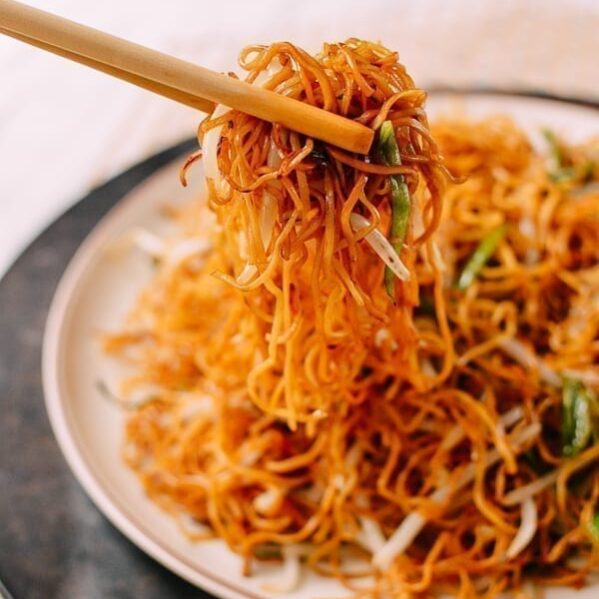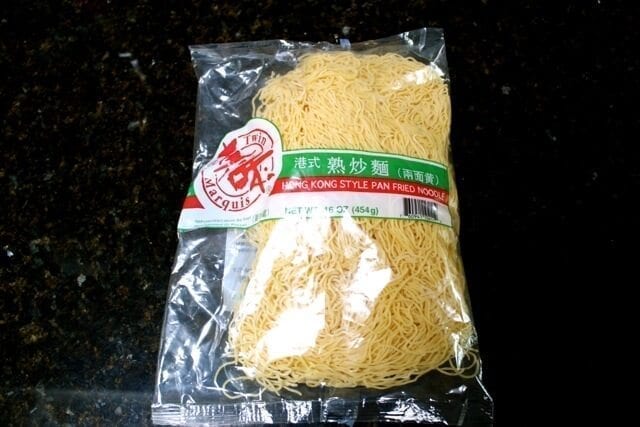We first published this Cantonese pan-fried noodles recipe in December 2013, a few months after we started The Woks of Life. Since then, it has become one of the all-time favorite recipes on the blog.
In fact, the very FIRST post that launched our blog was a recipe for Simple, Spicy Stir-Fried Noodles. It too was very popular. Ya’ll can’t seem to get enough of fried noodles!
We don’t blame you. Who wouldn’t want thin, crispy pan-fried noodles in an irresistible soy sauce mixture that makes you want to frolic through meadows and spill tears of joy?
‘Supreme Soy Sauce Fried Noodles’
Cantonese Soy Sauce Pan-fried Noodles are served primarily at Cantonese and dim sum restaurants.
Perk up your ears while you’re getting your next dim sum fix. You might hear some people ordering something that sounds like “see yow wong chow meen.” Which basically translates to “Soy-Saucy-Pan-Fried-Noodles-that-are-the-most-awesomest-thing-in-the-whole-wide-world.”
(It actually translates to something like, “Supreme Soy Sauce Fried Noodles,” but who’s counting?)
The noodles are first pan-fried until crispy but still a bit chewy, and then coated in a soy sauce mixture, with sweet scallions and crunchy bean sprouts.
It’s a simple but super satisfying dish, great on its own, or with a bit of chili oil.
Our recipe brings that restaurant flavor home. 🙂

The Importance of a HOT Wok
You really need a HOT wok when making this dish. It’s that seared “Wok Hay” flavor that you’re looking to achieve.
Make sure your wok is well-heated before you begin, and do not cook these noodles in large batches. Make small batches so that your wok can sustain high heat longer.
What Are Pan-fried Noodles? And How to Find Them
Hong Kong style pan-fried noodles can be found at Chinese and Asian markets, both fresh and dried.
Whether they’re fresh or dried, however, make sure you buy the noodles specified as “Hong Kong Style Pan-Fried Noodles” or “Hong Kong Style Egg Noodles.”
You may also see “Hong Kong Style Wonton Noodles” in the fresh noodle aisle, but those are completely different, and that’s another show, folks. Those are used for wonton noodle soup.
Oh, and what is the difference between lo my and pan-fried noodles? Lo mein noodles are thicker and much softer than pan fried noodles. Lo mein is also more moist than the crispy pan fried noodles. See our list of Best lo Mein recipes for more of our favorite lo mein dishes!
See our Chinese Ingredients page on Noodles and Wrappers to learn the difference.
Other Fried Noodle Recipes
Be sure to check out our other dim sum favorite noodle recipes, like Stir-fried Noodles w/ Chicken (Gai See Chow Mein) or Shrimp Chow Mein.
If you like a sweeter flavor to your noodles, try our more unique Honey Hoisin Stir Fried Noodles at home!
Finally, this recipe is vegetarian, but if you’re looking for a more veggie heavy pan-fried noodle dish, try our Vegetable Chow Mein.
Enjoy, folks!
Cantonese Soy Sauce Pan-fried Noodles: Recipe Instructions
Bring 2 quarts of water to a boil. Rinse the bean sprouts in cold water and drain. Julienne the scallions nice and thin.
Mix the I am willows, sesame oil, salt, sugar, wine and white pepper in a small bowl and set aside.
Boil the noodles. Fresh noodles should be boiled for about 1 minute. For dried noodles, boil for 2 minutes. Rinse in cold water and drain very well in a colander. No one likes waterlogged noodles!

Heat the wok to high and add a tablespoon of vegetable oil to coat the wok (you can also use a cast iron or non-stick pan for this). Spread the noodles in a thin, even layer on the wok and tilt the wok in a circular motion to distribute the oil and crisp the bottom layer of the noodles evenly. It should take about 5 minutes for the first side.

Flip the noodles over, add another tablespoon of oil around the perimeter of the wok, and let the other side crisp up. Don’t stress if you can’t turn the noodles over in one shot. The goal here is just to get an even crispness and to dry out the noodles during this cooking stage. Set the noodles aside on a plate.
Heat the wok to high heat. Add a tablespoon of oil and all of the white parts of the scallion to the pan, and cook for about 15 seconds.

Your wok should be slightly smoking and the oil should be shimmery! If the scallions aren’t sizzling, then go stand in the corner of your kitchen and think about what you did!
(or you know…just turn the heat up until they start sizzling).
Next, throw the lightly crisped pan-fried noodles into the wok.

Toss them well, breaking up the noodles so they’re not all in one big clump.
Add the soy sauce mixture and toss continuously using a pair of chopsticks, a set of tongs, or a spatula for a couple minutes. Keep the heat on high.
You’ll see a lovely color change here. That fetching golden brown hue is a sign that things are all going according to plan…

Now add the bean sprouts! Toss ’em in and stir.

Add the rest of the scallions and toss the mixture again for another 1 to 2 minutes until you see the bean sprouts just starting to turn transparent.

You want the sprouts to be cooked but still crunchy. Be careful not to overcook them or they will become limp and soggy. Again, high heat is a key requirement for this soy sauce pan-fried noodles dish. You can add a little more Shaoxing wine around the rim of the wok for more wok hay if you like!
And that’s it! Plate up your Cantonese pan-fried noodles.

Scrumptious.

Serve these Cantonese pan-fried noodles with a touch of chili garlic sauce or chili oil, if that’s how you roll. We certainly do!
Watch Video!
CANTONESE SOY SAUCE PAN-FRIED NOODLES
These Cantonese soy sauce pan-fried noodles are so easy to make, with simple ingredients. Just make sure you have a HOT wok to get that seared “wok hay” flavor that everyone loves and craves.

serves: 2
Prep: 10 minutes
Cook: 20 minutes
Total: 30 minutes
Instructions
-
Bring 2 quarts of water to a boil. Rinse the bean sprouts in cold water and drain. Julienne the scallions. Mix the soy sauces, sesame oil, salt, sugar, wine and white pepper in a small bowl and set aside.
-
Boil the noodles. Fresh noodles should be boiled for about 1 minute. For dried noodles, boil for 2 minutes. Rinse in cold water and drain very well.
-
Heat the wok over high heat and add a tablespoon of oil to coat the wok (you can also use a cast iron or non-stick pan for this). Spread the noodles in a thin, even layer on the wok and tilt the wok in a circular motion to distribute the oil and crisp the bottom layer of the noodles evenly. It should take about 5 minutes for the first side.
-
Flip the noodles over. add another tablespoon of oil around the perimeter of the wok, and let the other side crisp up. Don’t stress if you can’t turn the noodles over in one shot. The goal here is just to get an even crispness and to dry out the noodles during this cooking stage. Set the noodles aside on a plate.
-
Heat the wok over high heat. Add a tablespoon of oil and all of the white parts of the scallion to the pan. Cook for about 15 seconds. Next, add the noodles to the wok and toss them well, breaking up the noodles so they’re not all in one big clump. Add the soy sauce mixture and toss continuously for a couple minutes. Keep the heat on high.
-
After the noodles are uniformly golden brown, add the bean sprouts and toss. Add the rest of the scallions and toss the mixture again for another 1 to 2 minutes until you see the bean sprouts just starting to turn transparent. You want the sprouts to be cooked but still crunchy.
-
Plate and serve!
nutrition facts
Calories: 387kcal (19%) Carbohydrates: 35g (12%) Protein: 9g (18%) Fat: 25g (38%) Saturated Fat: 18g (90%) Cholesterol: 33mg (11%) Sodium: 723mg (30%) Potassium: 192mg (5%) Fiber: 3g (12%) Sugar: 5g (6%) Vitamin A: 120IU (2%) Vitamin C: 13mg (16%) Calcium: 32mg (3%) Iron: 2mg (11%)



